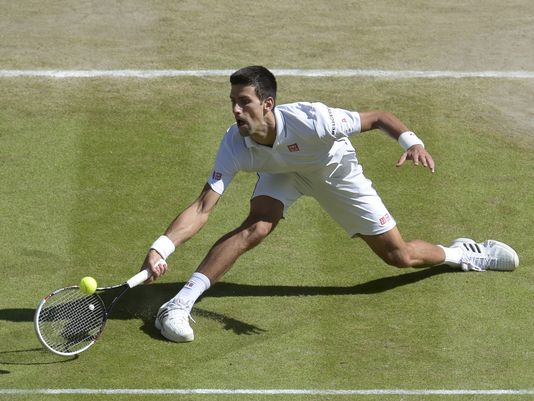Dear
Tennis players are able improve their groundstrokes and shots through a mix of repetition and practice in training and coaching sessions. The ability to work on your shot over and over again and eliminate errors is the key reason why coaching is so important. Structured coaching also allows players to use the skills and experience of their mentor to isolate very specific mistakes in their shot delivery and execution that prevent them from hitting the best possible groundstroke.
However, there are also some limitations to one on one or group coaching dynamics. The major one is that hitting balls that are served up by a coach from a bucket of balls means that the natural variations of the return shot that an opponent will test you with are lacking. This problem is even more prominent when using a ball machine, as it is unable to replicate when a ball travels oddly after a human player “frames” the shot or hits an angle impossible for a machine to replicate.

To move your tennis to the next level and improve your game it is necessary to develop tennis groundstroke flexibility. This article looks at five essential groundstrokes variations that you need to know. These variations encompass all the types of shots that you have to adapt to the situations that arise in match play. Let’s take a look at them.
The Neutral Shot
The neutral shot may not have the most attractive sounding name, but it is a crucial part of every players skill set. The reason is that this shot is the one that builds the point before you are able to target a “winner”. If you watch the top players, what separates the Djokovic and Nadal quality players from the rest is the ability to remain patient and wait for the perfect opportunity before going for
the big shot to end the rally and win the point.
Therefore the neutral shot should have a focus on consistency and the placement should be deep in the court. A good way to quantify the speed at which to hit a neutral shot is by setting a goal to hit six to eight shots in a row without missing. If you are able to do that, it means that you are capable of controlling the ball at higher speeds and therefore should be more aggressive to increase the effectiveness of your game.
The Shoulder Level Shot
Watching junior and amateur players, it is surprising how often a high looping ball return will end up at the bottom of the net, wasting a perfect opportunity to punish an opponent for a weak shot. The reason for this is that players do not adapt well enough to the short and high ball.
The most important thing to do with his shot is attack the ball. The basics for the shot are the same; use your feet to make the
ground to the ball so you can slow down slightly before you hit it. If you reach the point of contact at a full sprint it is more likely you will hit the ball long.
The next choice you have to make is whether to hit a volley or hit the shot on the bounce. If it is a volley then remember that a “push” to direct the shot rather than a long follow through is the best way to approach the shot. If you choose to hit a groundstroke on the bounce then your preparation should be at the shoulder level, allowing you to hit through the ball with little spin. The objective of the shot is to hurt the opponent.
The Half Volley
Half volleys are the shots that bounce halfway in the court, they are not quite a volley, but are also not deep enough for a traditional tennis groundstroke. These shots are challenging, but the best way to approach them is to turn the half volley into a full volley or play it as a modified chip shot.
To play the shot as a volley quick footwork is required to charge toward the net and catch the ball while it is still high enough to play a volley. The chip is the other option, and involves lowering the top of your racquet head to face the ground to counter the low bounce of the ball to flick it over the net. Be warned, however, a chip shot can invite your opponent to attack the ball with a volley or overhead lob.
Another situation where you need to use the half volley is when the opponent’s ball lands very close to you and you are not able to back up or when you are returning a first serve. In both cases, shorten your backswing and drive through the ball using the opponent’s pace. The goal of the shot is to return to a neutral situation in the point.
The Dipping Shot
The dipping shot is a shot that is best used when trying to keep the ball low over the net. This kind of shot is best employed when an opponent is
approaching the net, meaning that it is commonly employed as a passing shot.
Executing it correctly means hitting the ball with a lot of topspin , using the wrist and forearm and finishing low toward the pocket of the non-hitting side of the body
The Lifting Shot / The Lob
The lob is a difficult to execute technique that can result in a clever way to catch an opponent off guard. The match situation that allows for this shot is when an opponent is on the net in the volley position.
A lob requires the tennis groundstroke to be modified to angle the racquet as a 45-degree or more angle to get the necessary lift behind the ball. How much angle you employ will depend on the position of the court and also the height of your opponent. This shot has a very high margin of error, as trying to lift it over an opponent and still land it in the court results in a small target to aim at in the court.
I
hope knowing these tennis groundstroke variations will get you think about building flexibility in your game. You have to ensure that your training programme incorporate all these groundstroke variations since they require a different technique. Mastering these five tennis groundstroke variations will surely bring your game to the next level!
To your tennis success,

Joel
Founder,
www.improve-your-tennis.com
Tennis Stories
Follow me on twitter
http://www.twitter.com/Joel_Loo
Find me on Facebook
https://www.facebook.com/improve.your.tennis


